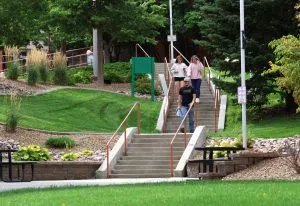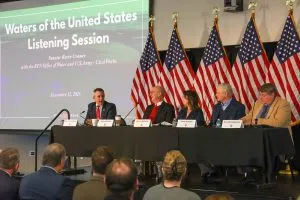
Students use a stairway on the Bismarck State College campus during Welcome Week at the school on Aug. 26, 2024. (Michael Achterling/North Dakota Monitor)
(North Dakota Monitor) -The cost to attend North Dakota’s public four-year universities is less than similar schools in the region, but students at the state’s two-year colleges pay more than the regional average.
That’s according to the most recent affordability report from the North Dakota University System.
The state’s 11 public colleges and universities resumed classes on Monday, with the first full day of classes Tuesday.
The average cost to attend a North Dakota four-year university last year was less than similar campuses in the region and nationally, the report says. The cost ranged from $16,691 for North Dakota regional four-year universities to $21,244 for undergraduate tuition at North Dakota State University and the University of North Dakota. The figures include resident tuition, fees, housing and food.
Meanwhile, the average cost to attend a two-year college in North Dakota was $14,511 last year, while students at similar campuses in the region paid an average of $12,993.
Bismarck State College President Doug Jensen attributes the disparity to the way North Dakota two-year colleges are funded. Many community colleges in other states receive local government support in addition to state funding, but not in North Dakota.
“When we make the statement that we’re higher than our peers, we’re not taking into account the local contribution that is being made in those communities,” Jensen told members of the State Board of Higher Education last spring.
The affordability study compared North Dakota with campuses in neighboring Minnesota, Montana and South Dakota, as well as Arizona, Colorado, Idaho, Nevada, New Mexico, Oregon, Utah, Washington and Wyoming. Community colleges in seven of the 12 comparison states receive some local funding, Brenda Zastoupil, North Dakota University System director of financial aid, said during the board meeting.
North Dakota undergraduate students will not see a tuition increase this school year due to action taken by the Legislature in 2023, which prevents the State Board of Higher Education from increasing tuition rates for the 2023-25 two-year budget cycle. A legislative committee that met last week said it’s premature to offer tuition guidance for the upcoming biennium.

Sophomore Brooke Burnett cited the affordability of higher education as a reason she left Montana State University in Bozeman to move to North Dakota for college. Attending Dickinson State University is “significantly cheaper,” Burnett said.
Tuition and fees make up slightly more than a third of a North Dakota University System student’s average cost of attendance. The lion’s share (64%) is taken up by housing and food, books and supplies, and miscellaneous expenses such as transportation and child care. An “open educational resources” initiative has reduced the average cost for books and supplies by 2% from the previous year, but it’s a drop in the bucket compared to the cost of rent, whether on or off campus.
“Housing is something that all of us students struggle with in one way or another — every single one of us,” Burnett said.
How students fund their education
The percentage of North Dakota undergraduate students who received some form of financial aid dropped to 54% in 2022-23, down from 61% the year prior. The number of students specifically borrowing federal funds also has declined. Those downward trends may partly stem from fewer North Dakota high school seniors submitting a Free Application for Federal Student Aid (FAFSA).
“In Montana, I know it’s a really, really big deal — the schools do tell us to fill out a FAFSA, and it’s something that we were prepped for,” Burnett said. “Truthfully, I don’t know many kids out of my (high school graduating) class who went to college and didn’t fill out the FAFSA. If you can get free money for college, why wouldn’t you?”
North Dakota does not require high schoolers to fill out a FAFSA as a graduation requirement, as is the case in 12 states, and has one of the lowest FAFSA completion rates of any state. However, it does participate in the “ND FAFSA Completion Project,” which aims to equip high school counselors with information.
“I am so lucky that I did do my FAFSA because I’m Pell Grant-eligible, and a lot of kids are,” Burnett said. “It helped me with being able to afford school.”
Federal student loans — whether subsidized, unsubsidized, or obtained through the Parent PLUS program — accounted for the majority of federal financial aid awards to students in the North Dakota University System. Federal Pell grants were the second-highest category, but it’s estimated that several billion dollars of federal Pell Grant funding are left on the table by high school seniors nationwide.
For North Dakota University System undergraduate students who took out loans, the average debt was $28,168 in 2023, the report states. The national average is $29,400 for 2021-22, the most recent year available.
For all North Dakota University System students, including those who did not borrow, the average debt was $14,768 in 2023.
While student loans continue to make up the majority of undergraduate financial aid, the availability of student funding that doesn’t require repayment is on the rise. The affordability report states that grant, scholarship and tuition waivers increased 9% in 2022-23 over the previous year.
For those who wish to “pay their own way,” the availability of work for enrolled students could also factor into a student’s decision to move to North Dakota after high school, as it did for Burnett.
“In Dickinson, it was really easy for me to find a job,” Burnett said. “I’m making a good amount of money — to the point that I could support myself in college.”
Amy Dalrymple contributed to this report.









